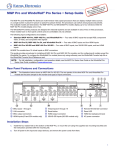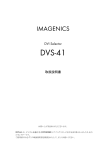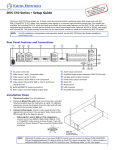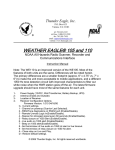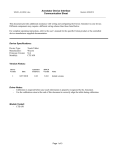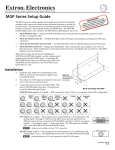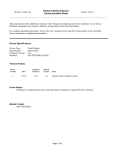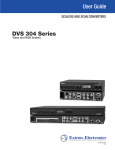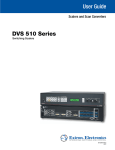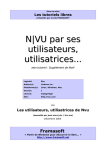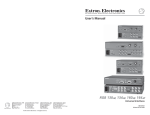Download Universal Remote Control Universl Remote Setup guide
Transcript
Product Category USP 507 • Setup Guide The Extron USP 507 (Universal Signal Processor) is a scaling product that allows most common signal formats to be processed and output in any desired format. This set up guide allows an experienced user to easily and quickly set up and configure a USP 507 using step by step instructions. It covers performing basic operations using the front panel controls and selected Simple Instruction Set (SIS™) commands. NOTE: For full installation, configuration, menus, and operation details, see the USP 507 User Guide at www.extron.com Installation Rear Panel Features 3 1 I N P U T R/ R-Y G/Y VID B/C 4 B-Y V R-Y VID 5 /Y VID /Y RGB/R-Y, Y, B-Y 2 RGB/R-Y, Y, B-Y 100-240 VAC 2A MAX 50-60Hz 1 2 4 3 B-Y /C HDSDI/ SDI 7 6 H/HV DVI-D C 5 15 10 7 G/ Y R/ R-Y O U T P U T B/ B-Y RS-232 DVI OUT 6 V S RGB/R-Y, B-Y, Y 9 8 Power and video input connections RESET LAN H 13 12 AUX SW FOLL0W MTP 14 11 Output, user interface, and control connections a AC power connector b RGB/HD, component, VGA connectors (inputs 1 and 2) c Universal BNC connectors (input 3) d Component/S-video/composite BNC connectors (input 4) e S-video/composite video BNC connectors (input 5) f DVI connector (input 6) g (Optional) HD-SDI/SDI connector (input 7) h RGB/HD, component, BNC connectors o Reset button and LED i RGB/HD, component VGA connectors j (Optional) output card* k MTP twisted pair connector l RJ-45 Ethernet connector m Control device 9-pin D-sub RS-232 connector n Auxilliary switcher 9-pin D-sub RS-232 connector *DVI card shown Mounting and Cabling Step 1 — Mounting Turn off or disconnect all equipment power sources and rack mount the USP 507 using the supplied brackets (see image at right). Step 2 — Connect inputs Connect inputs from video sources to the applicable connectors marked “Inputs”. See b through g above for connector types and the image below for signal format. RGsB/Component Video (R-Y, Y, B-Y) RGBS/ RGBcvS video RGBHV R/ R-Y G/Y VID H/HV V B/C B-Y R/ R-Y H/HV G/Y VID V B/C B-Y R/ R-Y H/HV G/Y VID V B/C B-Y S-video Composite video VID /Y VID /Y C C Rack Mount Bracket Step 3 — Connect outputs Connect video output devices to the applicable connectors marked “Outputs” (see h through k above). CAUTION Do not connect an MTP cable to the LAN port, or connect a LAN cable to the MTP port. Step 4 — Connect control devices LAN Ethernet port l — Connect an Ethernet LAN or WAN via this RJ-45 connector for remote control of the USP 507 using an Internet browser on a connected PC, or the Extron Signal Processing Product Control Program (SPPCP). One Ethernet connection LED lights green when connected to the LAN and one flickers amber as the devices communicate. NOTE: Do not use standard telephone cables for LAN connection, as they do not support Ethernet or Fast Ethernet. Do not stretch or bend cables as transmission errors could occur. RS-232 ports — For serial RS-232 or RS-422 control, connect a host computer or control system to the upper 9-pin D connector m. RS-232 protocol (default values): 9600 baud, 1 stop bit, no parity, 8 data bits, no flow control. 1 USP 507 • Setup Guide (Continued) Aux SW Follow port — For auxiliary device switching; using a NULL RS-232 cable only, connect an Extron audio switcher/processor, such as the SW 8A, to the lower 9-pin D-sub RS-232 connector n. When the USP 507 switches input via either a control device RS-232 command, or front panel control, the USP 507 and the connected auxiliary device will switch inputs simultaneously. When video is muted or unmuted, frozen or unfrozen, a corresponding audio mute/unmute command is sent to the auxiliary switcher. Step 5 — Connect power AC power connector — Plug in a standard IEC power cord from a 100 to 240 VAC, 50 - 60 Hz power source into this receptacle a. Powering Up When powering up the USP 507, the unit undergoes a self testing sequence (see image below). The LCD displays the default display cycle, showing the output rate and the refresh rates for the currently selected input. When not in any menu mode the screen cycles through the input/output configuration currently installed. Apply Power Menu and Next buttons remain lit. 1 sec. 10 sec. Extron USP 507 v1.xx MENU 3 sec. Input #2 60.0kHz 75.0Hz 2 2 sec. Output Rate 1024x768 60.0Hz 2 sec. Key = unlit 2 1 1 1 Last active input sec. button remains lit. 3 sec. All buttons flash in sequence (green, red, amber). 1 sec. NOTE: NEXT Default Display Cycle = lit = flashing When in use and not in any menu mode, the LCD screen defaults to cycling through the current input/output status. The displayed content may vary depending on the input video signal type (see typical default display above). Front Panel Overview ADJUST INPUTS 1 2 3 4 5 6 MUTE AUTO IMAGE SIZE BRIGHT /CONT DETAIL MENU FREEZE PIP PRESET POSITION COLOR /TINT ZOOM /PAN NEXT 7 USP 507 UNIVERSL SIGNAL PROCESSOR 1 2 3 4 5 6 7 a Front panel configuration port — Connect a control system or computer to this (RS-232) port, using a TRS RS-232 cable, Extron part number 70-335-01. RS-232 protocol (default values): 9600 baud, 1 stop bit, no parity, 8 data bits, no flow control b Input buttons — Selects/switches inputs, indicating which input is active (current input lights amber, PIP input lights green). c Special function buttons — These four, dual colored buttons are: • Mute — Allows the displayed image to be muted or umuted. • Freeze — Allows the current displayed image to be frozen or unfrozen. • Auto Image™— Allows automatic image adjustment on selected input. • PIP Preset — Allows the current PIP layout to be saved as a preset, or recalls a saved PIP preset layout. d Picture contol buttons — These six, dual colored buttons are: • Size — Allows adjustment to the displayed image size. • Position — Allows horizontal and/or vertical position adjustment of the displayed image. • Bright/Cont — Allows adjustment of the brightness and contrast settings for the displayed image. • Color/Tint — Allows adjustment of the color and tint settings for the displayed image. • Detail — Allows adjustment of the detail (sharpness) setting for the displayed image. • Zoom/Pan — Allows displayed image to be zoomed in or back out, or panned horizontally and/or vertically. e LCD display — This 16x2 screen displays device settings and menu configuration information. f Menu navigation buttons (Menu, Next) — These buttons allow navigation through the USP 507 menu system. g Adjust knobs — These are used with the picture adjustment and the menu navigation buttons to adjust settings. Setting the Front Panel Locks (Executive Modes) The USP 507 has three modes of front panel security lock that limit the operation of the unit from the front panel. Executive mode 0 (disabled) — The front panel is fully unlocked. This is the default setting. Executive mode 1 (enabled) — The front panel is locked except for input switching, video freeze, and auto image. Executive mode 2 (enabled) — The front panel is completely locked and can only be enabled and disabled using Extron Simple Instruction Set (SIS™) commands. See the online USP 507 User Guide for SIS commands. 2 Enabling or disabling Executive mode 1 from the front panel LCD screen displays either If the USP 507 is in Executive mode 0 (unlocked), the procedure shown at right selects mode 1 (locked). If it is in Executive mode 1, this procedure selects mode 0 (unlocked). When Executive mode 1 is enabled and a front panel action is attempted (other than video freeze, input switching, PIP preset recall, and auto image), the status is displayed for 2 seconds. Press and hold for about 2 seconds. Executive Mode Enabled SIZE or Executive Mode Disabled POSITION Configuring the USP 507 The USP 507 can be configured by any of the following: via the front panel, the Extron Signal Processing Products Control Program, through the internal web page, or via RS-232/Ethernet using SIS commands (see rear page). Front Panel The processor has seven front panel configuration menus: User Presets, Input Configuration, Output Configuration, Image Capture/ Recall, Advanced Configuration, View Comm Settings, and Exit Menu. A hidden menu (Edit Comm Settings) is also accessible. A Scan Converter or Aux Scaler menu appears if an optional card is installed. User Presets Menu Input Configuration Menu Output Configuration Menu Image Capture/Recall Menu Advanced Configuration Menu View Comm Settings Menu Scan Converter Menu Exit Menu Press NEXT or Aux Scaler only where an optional card is installed To use any menu, press the Menu button to access the main menu, then repeatedly press the Menu button to cycle through to the desired menu. Press the Next button to enter and cycle through the desired submenu. NOTE: Press Menu at any time to exit a submenu and return to the main menu. For detailed information on the menus, see the USP 507 User Guide, available online at www.extron.com. To configure the USP 507 using the front panel, follow the steps below: 1. Within the Output Configuration menu, use the Adjust knobs to configure the output rate and resolution, the output signal type, and the sync polarity to match the requirements of the display device. 2. From the Advanced Configuration menu, Test Pattern submenu, select the Alternating Pixels (Alt. Pixels) test pattern. Adjust the active pixels (size), total pixels (clocking), and pixel phase (fine sync) settings for optimal picture quality. 3. From the Advanced Configuration menu, change the test pattern to Crop, and adjust the display's position settings until all four sides of the crop pattern are visible. Disable the test pattern. No further adjustments or Auto Images should be performed on the display device. 4. Use the Advanced Configuration menu to set the Aspect ratio (Fill or Follow). Rotate either Adjust knob to the desired setting. 5. Perform Auto-Image on each USP 507 input. Auto-Image is a quick way to size an input to fit the current window size. To perform Auto-Image on an input, press the Auto Image button then press it again to confirm. Alternatively; use the Input Configuration menu to make any desired advanced adjustments, including turning on or off Film detection, Horizontal and Vertical Start, Pixel Phase, Total Pixels, Active Pixels, and Active Lines. 6. Use the Picture Control buttons to adjust Size, Position, Brightness, Contrast, Color, Tint, Detail, Zoom, and Pan if needed. 7. Use the User Presets menu to save the adjustments to each input for manual recall later. Signal Processing Product Control Program To configure the unit using SPPCP, the program must be installed (from the included DVD or download from www.extron.com) on a PC that is connected to the USP 507 via an RS-232 or a LAN connection. The installation creates a C:\Program Files\Extron\ Signal Processing folder and installs the SPPCP program, a Help file, and an Uninstall SPPCP program. Once installed, start the SPPCP program and either connect via the comm (RS-232) port or by TCP/IP. For full SPPCP instructions press <F1> or click on Help, Contents. Web page The USP 507 can be configured, controlled, and operated through its Ethernet port, connected to a LAN or WAN, using a Web browser such as Microsoft® Internet Explorer®. The browser displays the unit factory-installed Web pages, which provide a means of viewing and operating the device. Access the HTML pages by entering the IP address of the unit in the browser Address field. NOTE: If the system administrator has not changed it, the factory-specified default IP address is 192.168.254.254. If the unit is password protected, enter the administrator or user password in the Password field. A user name entry is not required. 3 USP 507 • Setup Guide (Continued) Using Image Capture/Recall Menu The Image Capture/Recall menu allows any one of up to 16 stored images to be recalled to the display, as either a background to an active video signal, or in front of the active signal. It also allows the user to store the current displayed image for later recall. To save an image: From within the Image Capture/Recall menu, press Next (the LCD displays “Save As: <N/A>”) and use either Adjust knob to scroll through 16 image names (IMG01.bmp through IMG16.bmp). 1. NOTE: When saving an image to a selected name, any image previously saved with that name is overwritten by the new image. 2. Press Next. The LCD displays “[Detail] = Confirm”, and the Detail button flashes red. 3. Press the detail button. The LCD changes to “Saving image Please wait”, then to “Saving image”. A progress bar indicates the progress of the image capture process. When the image is saved the LCD reverts to the default menu. To recall an image: 1. From within the Image Capture/Recall menu, press Next until the LCD displays “Recall to back: <N/A>”, or “Recall to front: <N/A>”. Select as desired and use either Adjust knob to scroll to the desired image. 2. Press Next to recall the image. While rendering, the LCD displays “Recalling image Please wait”. When the image is fully rendered, the name of the image is shown and “Recalled”, (for example, “IMG05.bmp Recalled”). The recalled image is now on the active display. Press Next to exit the Recall Image menu. To remove an image: Press Next while the LCD displays “Recall to back: <N/A>”, and again when it states “Recall to front: <N/A>”, until “Image Capture/Recall" is displayed. Press Menu to exit the Image Capture/Recall menu. The image is removed from the display screen but remains in the memory of the USP 507. Using PIP Presets The PIP Preset button allows any one of up to 16 PIP window layouts to be recalled to the display, or allows the user to save a PIP layout for later recall. Of the 16 layouts, ten are factory default positions (shown at right). The other six are user customizable. 33 44 7 8 22 11 6 5 To recall a layout: Press the PIP Preset buttons and scroll to the desired layout using the adjust knob. Press Next to recall the layout. 9 To save a layout as a preset: Press and hold the PIP Preset button until the LCD displays “Save to PIP Preset”. Use either adjust knob to scroll to the desired layout. Press Next to save the layout. Main = 10 PIP = Basic SIS Commands Table The USP 507 can be configured with specific SIS commands via RS-232 or a LAN connection. This table lists a selection of the commands. For a full list of SIS commands refer to the USP 507 User Guide, online at www.extron.com. Command ASCII command (host to switcher) Additional description Select input X!! InX!] Select video from input X!. Execute Auto-Image A Img] Execute auto image for current input. Mute video to black 1B Vmt1] Mute video and display a black screen. Unmute video 0B Vmt0] Unmute the video. Freeze input 1F Frz1] Freeze selected input. Unfreeze input 0F Frz0] Unfreeze selected input. PIP on EX!Pip} PipX!] Turn on PIP and display input X!. PIP off E0pip} Pip0] Turn off PIP. Swap % Tke] Swap between main and PIP windows. Recall PIP preset 3*X2^. 3RprX2^] Recalls PIP preset. Save PIP preset 3*X2^, 3SprX2^] Saves PIP preset. NOTE: X! = Input number (1 – 7) X2^ = PIP presets (1-16) Extron USA - West Headquarters Extron USA - East Extron Europe Extron Asia Extron Japan Extron China Extron Middle East +800.633.9876 +800.633.9876 +800.3987.6673 +800.7339.8766 Inside Asia Only +81.3.3511.7655 +81.3.3511.7656 FAX +400.883.1568 Inside Europe Only +971.4.2991800 +971.4.2991880 FAX +1.919.863.1794 +1.919.863.1797 FAX +31.33.453.4040 +31.33.453.4050 FAX +65.6383.4400 +65.6383.4664 FAX Inside USA/Canada Only 4 Response (switcher to host) +1.714.491.1500 +1.714.491.1517 FAX Inside USA/Canada Only Inside China Only +86.21.3760.1568 +86.21.3760.1566 FAX © 2011 Extron Electronics All rights reserved. www.extron.com 68-1796-50 Rev. B 05 11




